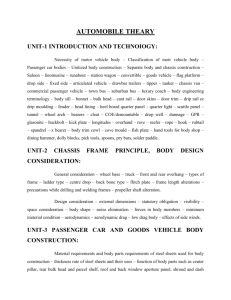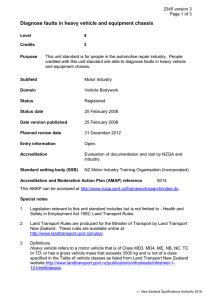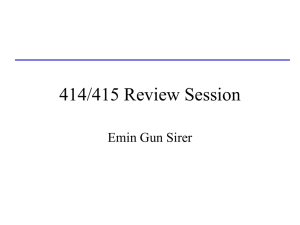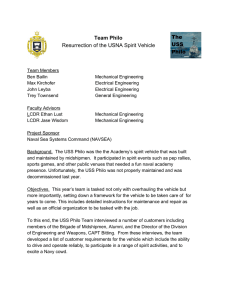ATV Chassis Design & Analysis: A Review
advertisement
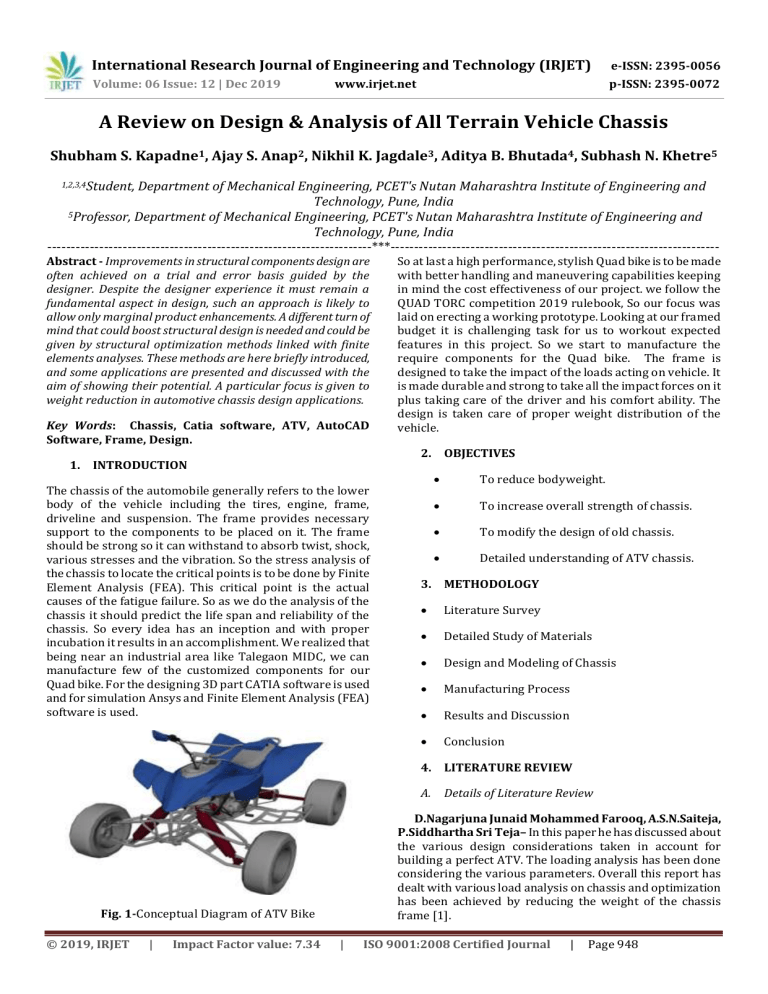
International Research Journal of Engineering and Technology (IRJET) e-ISSN: 2395-0056 Volume: 06 Issue: 12 | Dec 2019 p-ISSN: 2395-0072 www.irjet.net A Review on Design & Analysis of All Terrain Vehicle Chassis Shubham S. Kapadne1, Ajay S. Anap2, Nikhil K. Jagdale3, Aditya B. Bhutada4, Subhash N. Khetre5 1,2,3,4Student, Department of Mechanical Engineering, PCET's Nutan Maharashtra Institute of Engineering and Technology, Pune, India 5Professor, Department of Mechanical Engineering, PCET's Nutan Maharashtra Institute of Engineering and Technology, Pune, India ---------------------------------------------------------------------***---------------------------------------------------------------------Abstract - Improvements in structural components design are often achieved on a trial and error basis guided by the designer. Despite the designer experience it must remain a fundamental aspect in design, such an approach is likely to allow only marginal product enhancements. A different turn of mind that could boost structural design is needed and could be given by structural optimization methods linked with finite elements analyses. These methods are here briefly introduced, and some applications are presented and discussed with the aim of showing their potential. A particular focus is given to weight reduction in automotive chassis design applications. Key Words: Chassis, Catia software, ATV, AutoCAD Software, Frame, Design. 1. INTRODUCTION The chassis of the automobile generally refers to the lower body of the vehicle including the tires, engine, frame, driveline and suspension. The frame provides necessary support to the components to be placed on it. The frame should be strong so it can withstand to absorb twist, shock, various stresses and the vibration. So the stress analysis of the chassis to locate the critical points is to be done by Finite Element Analysis (FEA). This critical point is the actual causes of the fatigue failure. So as we do the analysis of the chassis it should predict the life span and reliability of the chassis. So every idea has an inception and with proper incubation it results in an accomplishment. We realized that being near an industrial area like Talegaon MIDC, we can manufacture few of the customized components for our Quad bike. For the designing 3D part CATIA software is used and for simulation Ansys and Finite Element Analysis (FEA) software is used. So at last a high performance, stylish Quad bike is to be made with better handling and maneuvering capabilities keeping in mind the cost effectiveness of our project. we follow the QUAD TORC competition 2019 rulebook, So our focus was laid on erecting a working prototype. Looking at our framed budget it is challenging task for us to workout expected features in this project. So we start to manufacture the require components for the Quad bike. The frame is designed to take the impact of the loads acting on vehicle. It is made durable and strong to take all the impact forces on it plus taking care of the driver and his comfort ability. The design is taken care of proper weight distribution of the vehicle. 2. OBJECTIVES To reduce bodyweight. To increase overall strength of chassis. To modify the design of old chassis. Detailed understanding of ATV chassis. 3. METHODOLOGY Literature Survey Detailed Study of Materials Design and Modeling of Chassis Manufacturing Process Results and Discussion Conclusion 4. LITERATURE REVIEW A. D.Nagarjuna Junaid Mohammed Farooq, A.S.N.Saiteja, P.Siddhartha Sri Teja– In this paper he has discussed about the various design considerations taken in account for building a perfect ATV. The loading analysis has been done considering the various parameters. Overall this report has dealt with various load analysis on chassis and optimization has been achieved by reducing the weight of the chassis frame [1]. Fig. 1-Conceptual Diagram of ATV Bike © 2019, IRJET | Impact Factor value: 7.34 Details of Literature Review | ISO 9001:2008 Certified Journal | Page 948 International Research Journal of Engineering and Technology (IRJET) e-ISSN: 2395-0056 Volume: 06 Issue: 12 | Dec 2019 p-ISSN: 2395-0072 www.irjet.net P. Vivekanandan, A. Vishnu, S. Pradeep, R.Sambasivam– In this paper he has discussed about how he dealt with the challenges faced in the design of the chassis. There was a special learning curve mentioned by him that the further the mass is kept away from the neutral axis the more rigid the frame will be. Their whole study attempted to analyze the stress on the chassis using the finite element analysis[2]. configurations of vehicles facing obstacles when climbing along ramps of different longitudinal slope have been modeled. Further analyses have been done in order to investigate the influence of the position of the center of gravity and obstacle traversing speed. Different asymmetrical bogie configurations have also been proposed to further improve the obstacle surmounting capacity of the 4-axle vehicle [8]. William B. Riley and Albert R. George– In this paper he has discussed about a variety of issues related to frame and chassis design. A simple mathematical model was developed for comparing the structural stiffness to gain insight into proper design targets for the vehicle structure. The model was constructed on the ANSYS and some experimental methods were presented which best captured the load parts, suspension contributors [3]. M. Senthil Kumar, C.D. Naiju, S. J. Chethan Kumar, Joseph Kurian –In this paper, the study is focused on analyzing the existing chassis design and the noise, vibration and harshness (NVH) characteristics are studied. Modeling of chassis structure is carried out using 3D modeling package CATIA V5 and finite element model is created by meshing using Hypermesh software [9]. Shaik Himam Saheb*., Ravi Sandeep Kumar., Abhilash Reddy G and Neela Sai Kiran - In this paper the design and construction for QBDC has been discussed. A detailed study of various automotive systems is taken as an approach. Thus, this report provides a clear insight in design and analysis of our vehicle. This project has helped in extensive learning and gaining practical knowledge on the theoretical concepts imparted in the classroom[4]. Upendra S. Gupta,SumitChandak,Devashish Dixit - In this paper, it provides in-detail description of the design considerations, static & dynamic analysis and mathematical data involved in the design of a ATV Vehicle. The focus has been laid on the simplicity of design, high performance, easy maintenance and safety at very reasonable prices. The design and development comprises of material selection, chassis and frame design, cross section determination, determining strength requirements of roll cage, stress analysis and simulations to test the ATV against failure [5]. Rushikesh Deshmukh, R N Patil – In this paper, they have introduced new design for quad bike chassis which is expected to show better performance and aesthetics when compared to conventional designs. The design is further tested for loading conditions like front impact and rear impact tests using ANSYS software tools. The results show that the proposed design has reduced values of stress and deformation which assure the safety of the chassis [6]. Wang Guoqing, Liu Shaojun, Zeng Yihui, Chen Lingping– In this paper, they have worked on a chassis and have performed analysis of all types mostly the stress nephogram of the chassis. They have done a lot of analytical work on the chassis and have made calculations of the same. An improved scheme is put forward by analyzing the dangerous part of the chassis. This paper has helped a lot in the analysis of the chassis and its calculation [7]. X.Potau, M.Comellas, M.Nogues, J.Roca – In this paper, the work aims to comparatively quantify the ability of overcoming obstacles that is achieved by using different configurations of vehicles with bogies. Different © 2019, IRJET | Impact Factor value: 7.34 | Denish S. Mevawala, Mahesh P. Sharma, Devendra A. Patel, Darshan A. Kapadia – In this paper the focus is mainly on the roll cage. The roll cage adds to the aesthetics of a vehicle. So determining strength requirements of roll cage, stress analysis is carried out using FEA software ANSYS workbench. This paper deals with design of roll cage for an ATV and Various loading tests like Front Impact, Side Impact and rear impact have been conducted. The modeling and stress analysis is done by ANSYS software. We have focused on every point of roll cage to improve the performance of vehicle without failure of roll cage [10]. Masanori Yoshihara -This paper intends to verify the following in order to clarify the influence of the body layout on ATV pitching behavior, and for the purpose of helping develop a more pleasing product, it reports the research results based on the theory and experiment concerning the effect of body geometry on vehicle dynamics, with particular emphasis on vehicle behaviors under acceleration and deceleration. A discussion of vehicles employing the chain drive or swing arm system involves a number of factors that contribute to pitching motion [11]. C. I. Chatzikomis · K. N. Spentzas -In this paper we compared the performance of a vehicle without any control systems, with a vehicle equipped with ESC, a vehicle with 4WS and a vehicle with both systems, in two standardized ISO vehicle dynamics tests and in a simulated lap of a realworld racing track. The vehicles equipped with active control systems, have consistently shown an improvement of their dynamic behavior, when compared to the vehicle with no control systems [12]. Deep Srivastav – in this paper, the objective of designing a single passenger off-road race vehicle with high safety and low production costs seems to be accomplished. After initial testing it will be seen that our design should improve the durability of all systems on the car and make necessary changes [13]. Savari Goutham, Arun Raj Dandothkar – this paper deals with the analysis of the failure of BAJA SAE chassis using FEA. The objective of this is to develop the chassis ISO 9001:2008 Certified Journal | Page 949 International Research Journal of Engineering and Technology (IRJET) e-ISSN: 2395-0056 Volume: 06 Issue: 12 | Dec 2019 p-ISSN: 2395-0072 www.irjet.net using the rules specified by the SAE. In this project describes the FEA techniques to predict the failure of chassis and identify critical locations of failure. In this paper analysis on the chassis is carried out in four scenarios they are front impact test, side impact test, roll over test, rear impact test [14]. Naresh Rajput, Er. Gaurav Mehta – In this paper, their endeavor is to develop and design a chassis for ATV and to conduct its finite element analysis using various software required for the SAE in order to develop robust and efficient ATV chassis design. In this it is demonstrated the desired satisfactory dynamic stability while maneuvering rough terrains in simulations [15]. Grzegorz Szczesniak, Paulina Nogowczyk, RafalBurdzik– In this article, the various important stages of vehicle production are described, which is design of chassis and frame. Also some examples of SSS for design concept in vehicle production have been depicted. Some short information about chassis and frame types used in special vehicles has been a lot helpful. These issues are very important for vehicle designers especially during assumptions and constructions of chassis and frame [16]. Hirak Patel, Khushbu C. Panchal, Chetan S.Jadav- In this report, work is performed towards optimization of the automobile chassis with constraints of maximum shear stress and deflection of chassis structural system like the chassis can be easily analyzed using FEA. A sensitivity analysis is carried out for weight reduction. So a proper finite model of chassis is to be developed. The chassis is modeled in pro-E & FEA is done on ANSYS workbench [17]. Shiva Krishna, AmebeshShetye,PrabhudevMallapur – This paper deals with the selection of material and cross section for the chassis and analyzing the frame design for different loading conditions to predict whether it will survive various impact scenarios using ANSYS software. The chassis design is based on BAJA SAE rule book. The results of this test indicate that the frame is safe enough for the variety of worst case scenarios tested [18]. A.K. Babu – This was another book that we referred from the library that helped us gain valuable calculation data and some another information regarding the chassis of vehicles. We can read the various loads acting on the chassis at various points. So we can choose the material according to the strength required [19]. Abdullah MohdAzmana, TamaldinNoreffendyb, Ramli FaizRedzac, SudinMohdNizamd - This project emphasizes on the practical and engineering applications of the subject’s vehicle Dynamics and Automobile Technology. A 110CC 4 stoke motorcycle engine is used for the power train Design and Analysis are performed by CAD software with further development and research, the ATVs are subjected for improvement. The sustainability of the design and development of ATV depends on the material selection, design criteria and components availability [20]. © 2019, IRJET | Impact Factor value: 7.34 | B. Literature Reveals As we have seen in most of the papers the design and manufacturing of different types of chassis has been discussed the main focus is given on the strength of the material which will be used for the design. The designing software used has been CATIA, Pro-E while the analysis is done on the ANSYS workbench. In the paper published by (Wang Guoqing) the analysis of all types has been performed mainly the stress analysis of the chassis. An improved scheme is put forward by analyzing the dangerous part of the chassis. The goal of all the designers has been to build a low cost ATV but not by compromising with its strength and other parameters. Most of the paper have been about the various analysis that have been carried out to create a chassis that is optimal on all the required parameters. (Denish S. Mevawala) This paper has mainly focused on the roll cage buildup. The aesthetics of the vehicle have been taken care of while designing. We have seen that the papers reveal a study of frontal impact, side impact, rear impact. The experiments conducted are very well planned according to the design considerations and parameters and made ensured that none of the components fail the test or break in the process of experimentation. (C.I.Chatzikomis) have compared the performance of a vehicle without any control system, a vehicle with ESC, a vehicle with 4WS and a vehicle with both systems. The objective has been to design the vehicle using the SAE rule book for various papers throughout the survey. The causes of fatigue failure in the ATV have been verified over and over and an optimal solution has been derived. A high performance ATV is all that is desired at the end of all the process. A prototype has generally been mode first in an attempt to check the vehicle for all the elements that have to be checked. (Hirak Patel) In his paper emphasizes on the weight reduction of the vehicle by carrying out a sensitivity analysis. The work has been focused towards the optimization of chassis with constraints of maximum shear stress and deflection of chassis. Thus, most of the paper have been about the various analysis that have been carried out to create a chassis that is optimal on all the required parameters. C. Expectations From our project here we expect the outcomes of the analysis we have done on the chassis design. From the literature we have got a good idea of how the analysis have been done earlier and what are the outcomes that are to be expected. We have started our knowledge from the very basics of how to design a chassis and the difference between a frame and chassis. We got to know about a few techniques which could save the cost of actual testing on by computational analysis of the components. The Fatigue stress and load analysis will give a clear view of how the chassis would act under certain conditions when its prone to uncertain conditions. We have got a clear view on certain parameters that will play an important part in the designing of the chassis that will be reliable. ISO 9001:2008 Certified Journal | Page 950 International Research Journal of Engineering and Technology (IRJET) e-ISSN: 2395-0056 Volume: 06 Issue: 12 | Dec 2019 p-ISSN: 2395-0072 www.irjet.net Trends and Technology (IJETT), Vol 20 Number 3,Feb 2015, pp. 131-138. 4) Rushikesh Deshmukh, R N Patil, “DESIGN AND STRUCTURAL ANALYSIS OF A QUAD BIKE CHASSIS”, International Journal of Advanced Technology in Engineering and Technology, Vol-3, Issue-12, December 2015, pp. 124-129. 5) Wang Guoqing, Liu Shaojun, Zeng Yihui, Chen Lingping, “Finite Element Analysis on Chassis of Tracked Test Vehicle”, IEEE Computer Society, 2012, pp. 334. 6) X.Potau, M.Comellas, M.Nogues, J.Roca, “Comparison of different bogie configurations for a vehicle operating in rough terrain”, Journal of Terramechanics (2011), pp. 75–84. Fig. 2-Actual Cad Mode 5. CONCLUSION The designing and analysis is a difficult part to carry on as these tests need to be conducted with a lot of constraints. It has been a challenging task looking at all the time and study constraints available. This report put a time light on all the major work available on the chassis built-up. The main motive as per the objectives that have been achieved are a well designed structure of chassis that will be optimized on parameters like weight and cost. ACKNOWLEDGEMENT First of all, I would like to give my sincere thanks to my guide Prof. S. N. Khetre for being our mentor. He offered us so much advice, patiently supervising & always guiding in right direction. We have learnt a lot from him & he is truly a dedicated mentor. His encouragement & help made us confident to fulfil our desire & overcome every difficulty we encountered. We would also like to express our gratitude to Prof. Shridhar Limaye, H.O.D., and Mechanical Engineering Department. We are also hugely obliged to Dr.Lalitkumar Wadhwa, Principal, for giving us the opportunity to continue my education &enhance the our knowledge. We would like to express our appreciation to all other professors who have offered us their time & valuable advice for encouragement and suggestions during the partial fulfilment of the review. REFERENCES 1) William B. Riley and Albert R. George, “Design, analysis and testing of a formula SAE car Chassis”, SAE Technical paper series 2002-01-3300, 2 December 2002. 2) Shaik Himam Saheb*., Ravi Sandeep Kumar., Abhilash Reddy G and Neela Sai Kiran, “Design report Quad bike challenge”, International Journal of Recent Scientific Research, Vol-8, Issue-1, January 2017, pp. 14996-15006 3) Upendra S. Gupta,SumitChandak,Devashish Dixit, “Design & Manufacturing of All Terrain Vehicle (ATV)Selection, Modification , Static & Dynamic Analysis of ATV Vehicle”, International Journal of Engineering © 2019, IRJET | Impact Factor value: 7.34 | 7) Denish S. Mevawala, Mahesh P. Sharma, Devendra A. Patel, Darshan A. Kapadia, “Stress Analysis of Roll Cage for an All Terrain Vehicle”, International Conference on Advances in Engineering & Technology – 2014 (ICAET2014), pp. 49-53. 8) Masanori Yoshihara, “The Influence of Body Layout on Vehicle Pitching Behavior in ATV”, Small Engine Technology Conference and Exhibition Pisa, November 28-30, 2001. 9) C. I. Chatzikomis · K. N. Spentzas, “Comparison of a vehicle equipped with Electronic Stability Control (ESC) to a vehicle with Four Wheel Steering (4WS)”, springer, pp. 14-25. 10) Deep Shrivastav, “Designing of All Terrain Vehicle(ATV)”,International Journal of Scientific and Research Publications, Vol 4, Issue 12,December 2014, pp 1-16. 11) Savari Goutham, Arun Raj Dandothkar, “Design And Optimization Of BAJA ATV Chassis ”, pp 1-5. 12) Naresh Rajput, Er. Gaurav Mehta, “Modeling & Finite Element Analysis (FEA) Of ATV Chassis To Enhance Efficiency”, International Journal of Advances in Engineering & Scientific Research, Vol.3, Issue 2, AprJun-2016, pp 1-17. 13) Grzegorz Szczesniak, Paulina Nogowczyk, RafalBurdzik, “Some basic tips in vehicle chassis and frame design”, Journal of measurement in engineering, Vol 2, Issue 4, December 2014, pp. 208-214. 14) Hirak Patel, Khushbu C. Panchal, Chetan S.Jadav, “Structural Analysis of Truck Chassis Frame and Design Optimization for Weight Reduction”, International Journal of Engineering and Advanced Technology(IJEAT) ISSN: 2249-8958, Vol 2, Issue 4, April 2013, pp. 665-668. ISO 9001:2008 Certified Journal | Page 951 International Research Journal of Engineering and Technology (IRJET) e-ISSN: 2395-0056 Volume: 06 Issue: 12 | Dec 2019 p-ISSN: 2395-0072 www.irjet.net 15) Shiva Krishna, AmebeshShetye, PrabhudevMallapur, “Design and Analysis of Chassis for SAE BAJA Vehicle”, IOSR Journal of Engineering (IOSR JEN), August 2019, pp. 51-57. 16) A.K.Babu, “Automotive Chassis”, Chapter 3, pp. 56-58. 17) Abdullah MohdAzmana, TamaldinNoreffendyb, Ramli FaizRedzac, SudinMohdNizamd, “Design and Development of Low Cost All Terrain Vehicle (ATV)”, Applied Mechanics and Materials, Vol. 663 (2014), pp 517-522. 18) M. Senthil Kumar, C.D. Naiju, S. J. Chethan Kumar, Joseph Kurian, “Vibration Analysis and Improvement of a Vehicle Chassis Structure”, Applied Mechanics and Materials, Vol 372 (2013) ,pp 528-532. © 2019, IRJET | Impact Factor value: 7.34 | ISO 9001:2008 Certified Journal | Page 952

